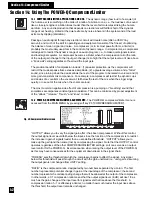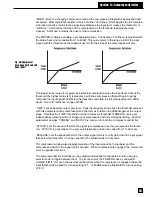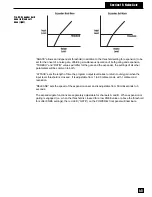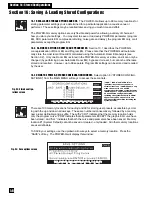
generation. The POWER-Q display will automatically switch to show the real-time analysis in
progress (displays the response you choose under soft key #4). Pressing the NOISE soft key
once more turns off the noise generator.
The fourth soft key chooses either the A or B channel input or output response of the POWER-Q,
or the frequency response of the program heard at the reference microphone (“REF”).
Press “MORE” to see the following screen:
The first soft key varies the peak and hold reset time of the RTA, from instantaneous (“P&H 0”),
where there is effectively no peak and hold; to 1 second (“P&H 1”); to 4 seconds (“P&H 4”); to
infinity (“P&H
4
"), which will display and hold the highest peak until it is reset. Peaks will show in
addition to the RTA display.
The second soft key chooses the weighting for the RTA response: none ("WT NO"), A weighting
(“WT A”), B weighting (“WT B”), and C weighting (“WT C”). In normalized mode, the RTA display
is scaled so that the highest peak is at the same level as the input level.
The third soft key opens the noise generation option menu (see description on page 39).
The fourth soft key (“CURVE”) shows on the screen the EQ response curve of the sum of all the
graphic, parametric, HPF, LPF, and FBX filters placed in the signal path. This can be displayed for
channel A ("CU A"), channel B ("CU B"), or both ("CU A&B").
Press "MORE" again to see the following screen:
"NOIS
" and "NOIS
" are "phantom" soft keys that only appear when you select an option in the
noise generation options window. Pressing "NOIS
" increases noise level, and pressing "NOIS
"
decreases noise level.
Press "MORE" again to see this screen:
40
Section 13: RTA
P&H 0/1/4/
4
:
Adjusts the peak and hold reset time of the RTA, from
instantaneous (P&H 0), to 1 second, 4 seconds or the
highest peak (
4
).
WT NO/A/B/C:
Choose among A, B or C weighting, or none (WT NO).
CURVE:
Superimposes the EQ response curve for channel A (CU A),
channel B (CU B), or both (CU A&B).
NOISE:
Opens the noise generation options window. Choose pink
or white noise for the output of channels A and/or B.
Fig. 46: Pressing MORE
gives you these options
FAST/SLOW:
Adjusts the response time of the RTA
from FAST to SLOW.
Opens the noise generation options
window. Choose pink or white noise for
the output of channels A and/or B.
Displays noise level.
These keys only appear when you select
pink or white noise in the noise
generation options window. They allow
you to adjust the noise level up or down.
Fig. 47: Pressing "MORE"
gives you these options
A/B/LINK:
Enables graphic EQ controls in the RTA
window for channel A, channel B, or
both (linked). Selecting "A" will also
enable digital delay adjustments for
channel A; selecting "B" enables delay
adjustments for channel B. Selecting
"LINK" defeats delay adjustments.
Opens the noise generation options
window. Choose pink or white noise for
the output of channels A and/or B.
Delay time setting (in milliseconds).
These keys allow you to adjust the delay
time up or down.
Fig. 48: Pressing "MORE"
gives you these options






























